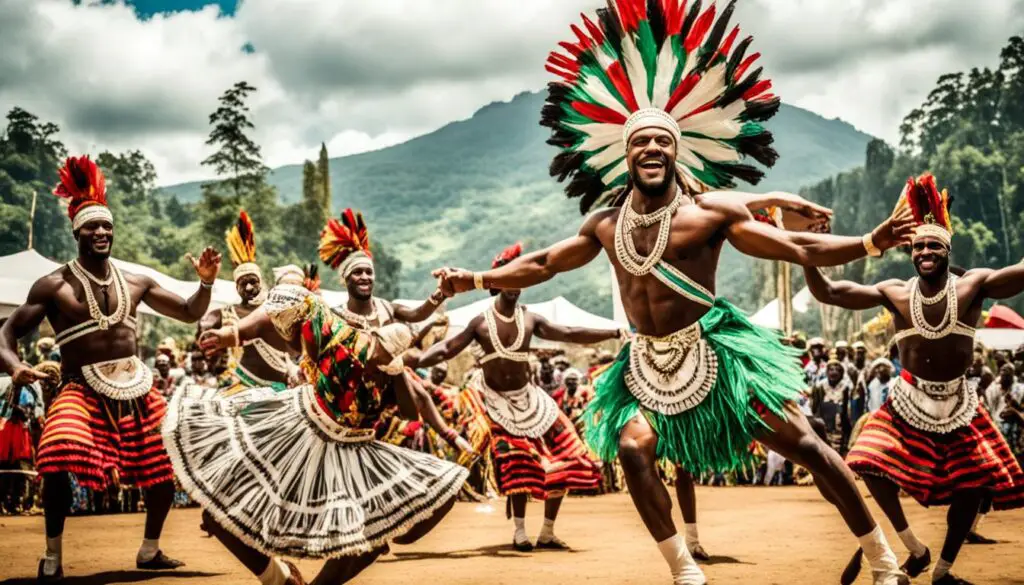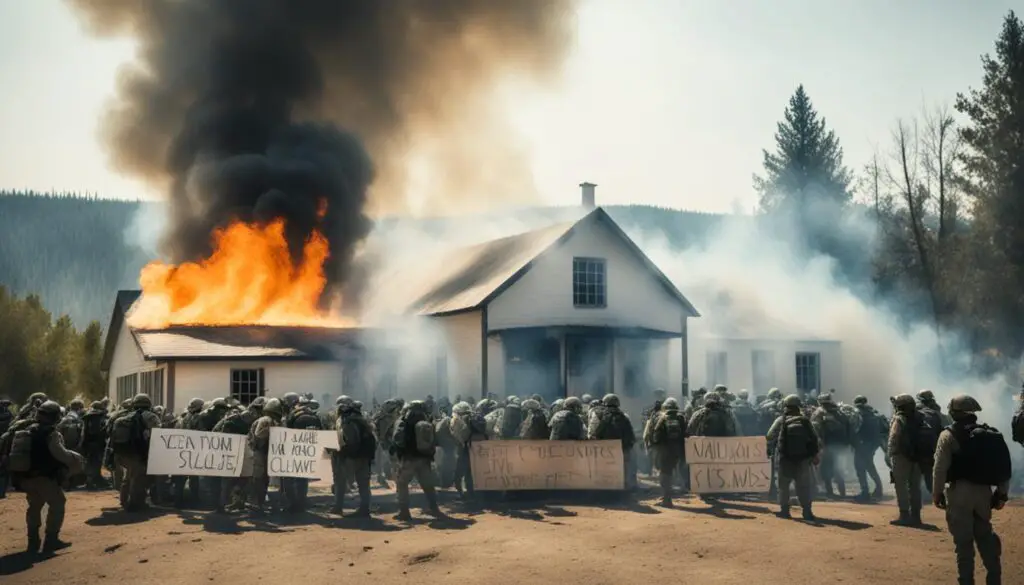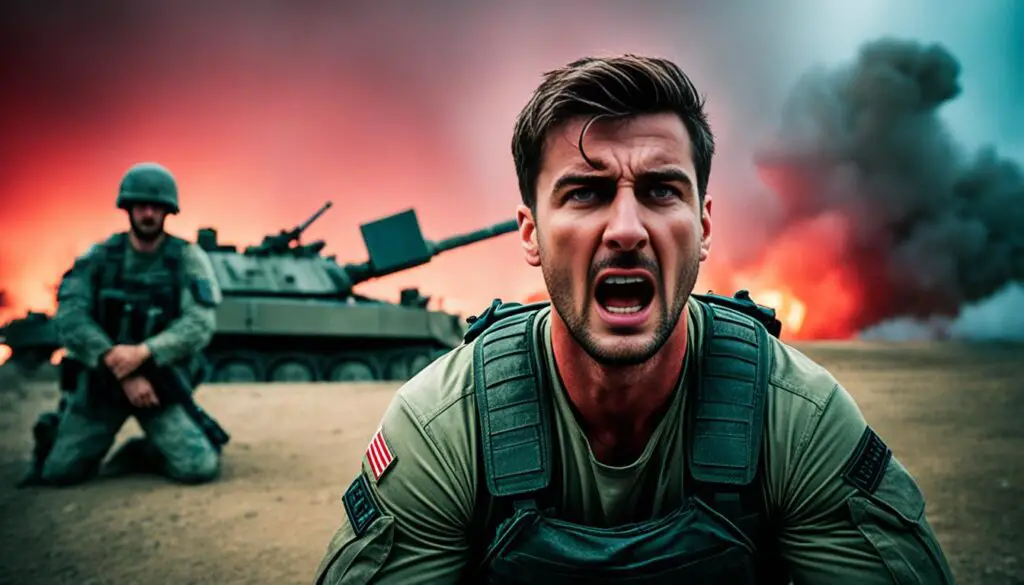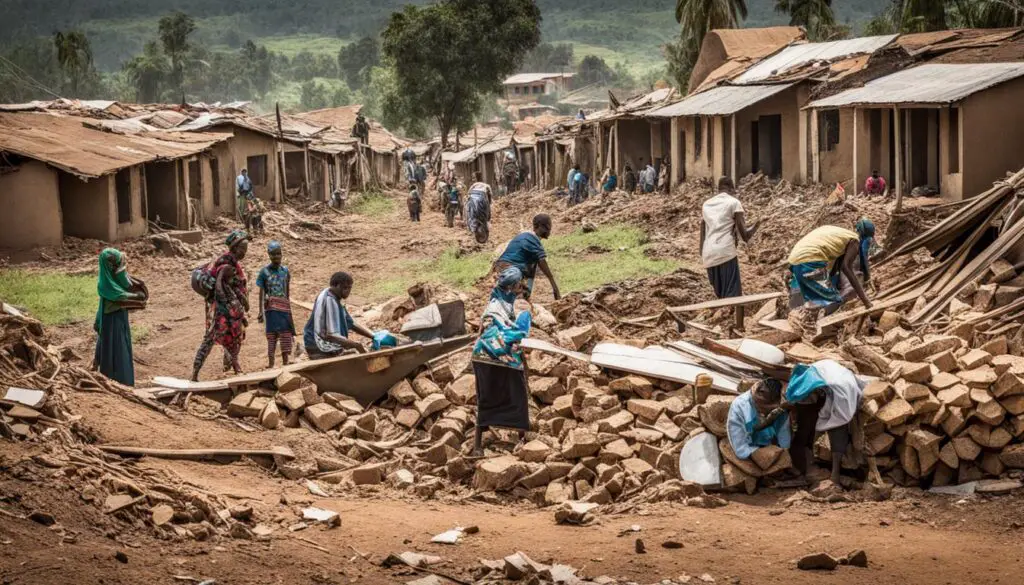Welcome to our in-depth exploration of the ongoing conflict and unrest in Cameroon. In this article, we will delve into the complexities of the situation, highlighting the various factors contributing to the current conflict. From historical tensions to human rights concerns, international involvement to armed groups, we will provide a comprehensive understanding of the challenges faced by the country and its people.
Key Takeaways:
- The conflict in Cameroon has caused significant humanitarian crises and has resulted in the displacement of many civilians.
- The Anglophone Crisis has played a major role in exacerbating the conflict in the English-speaking regions.
- The Cameroonian government’s response to the conflict has been criticized for alleged human rights abuses.
- The international community has been engaging in diplomatic efforts to help resolve the conflict and provide humanitarian aid.
- Efforts for conflict resolution and reconciliation are being made, but a lasting solution is yet to be achieved.
Historical Background of Cameroon
To understand the current conflict in Cameroon, it is important to delve into the country’s history. Cameroon, located in Central Africa, has a rich and complex past that has shaped its present-day situation. From colonization to independence, Cameroon has experienced various historical conflicts and tensions that continue to have repercussions today.
Cameroon’s history can be traced back to pre-colonial times when it was inhabited by a diverse range of ethnic groups. The region was influenced by numerous kingdoms and empires, including the powerful Tikar, Bamum, and Fulani states.
The arrival of European powers in the late 19th century marked a turning point in Cameroon’s history. The country was divided between the German Empire and the French and British colonial administrations during the Scramble for Africa. This division resulted in the establishment of two distinct regions: the French-speaking majority in the east and the English-speaking minority in the west.

When Cameroon gained independence in 1960, these linguistic and cultural differences remained, laying the foundation for future conflicts. The struggle for power and resources between the Francophone-dominated government and the Anglophone minority led to tensions that escalated over the years.
In the 1980s, a wave of popular protests demanding greater political representation and economic opportunities emerged. These protests were met with a heavy-handed response from the government, resulting in further resentment and fueling the flames of conflict.
Throughout the years, various separatist movements and armed groups have emerged, advocating for the rights of the English-speaking regions and calling for secession from the predominantly Francophone country. The historical conflicts and grievances of the past have contributed to the current situation of unrest and violence in Cameroon.
In the subsequent sections, we will delve deeper into the specific conflicts and dynamics that have unfolded in Cameroon, including the Anglophone Crisis, government response, international involvement, and the impact on civilians. By understanding the historical background of Cameroon, we can gain a better perspective on the complexities of the current conflict and the potential paths towards resolution.
The Anglophone Crisis
The Anglophone Crisis has emerged as a significant catalyst for the ongoing conflict in Cameroon. It centers around the grievances of the English-speaking regions in the country, which have felt marginalized and overlooked in various aspects of governance, education, and cultural representation.
The crisis traces its roots back to the colonial period when Cameroon was partitioned into French and British territories. Following independence, the English-speaking regions became part of a unified Cameroon but retained their distinct legal and educational systems.
Over time, tensions grew as the Anglophone community felt that their identity and rights were being eroded. In 2016, lawyers and teachers in the Anglophone regions led peaceful protests against perceived discrimination. However, the government’s heavy-handed response, including arrests and internet shutdowns, escalated the situation, leading to an armed secessionist movement.
The separatist groups, primarily the Ambazonia Defense Forces, emerged with the goal of establishing an independent state called Ambazonia. They have engaged in acts of violence, targeting both government forces and Anglophone civilians.
The government’s response to the crisis has been criticized for its heavy military presence, human rights abuses, and restrictions on press freedom. The conflict has led to numerous killings, mass displacement of civilians, and the deterioration of infrastructure and public services in the affected regions.
The Anglophone Crisis has significant implications for the unity and stability of Cameroon, as well as its economic development. It is a complex issue that requires careful analysis, dialogue, and efforts towards finding a lasting resolution that addresses the legitimate grievances of the English-speaking regions while upholding peace and justice.

Exploring the Origins of the Anglophone Crisis
To understand the origins of the Anglophone Crisis, it is important to delve into the historical context of Cameroon and the factors that have contributed to the current conflict. This section will explore the colonial legacy, post-independence challenges, and the gradual escalation of tensions between the Anglophone and Francophone communities.
Government Response and Human Rights Concerns
One of the critical aspects of the conflict in Cameroon is the government’s response to the ongoing crisis and the concerns raised regarding human rights abuses. As various organizations and groups have highlighted, the situation has been marred by allegations of violations against the civilian population.
The Cameroonian government has faced criticism for its handling of the conflict and its approach towards resolving the tensions. Organizations such as Amnesty International and Human Rights Watch have documented incidents of extrajudicial killings, arbitrary arrests, torture, and the use of excessive force by security forces in response to protests and demonstrations.

These reports have raised international awareness and prompted calls for accountability. Concerns have been expressed about the lack of transparency and impartiality in investigations into the alleged human rights abuses. The government’s response to these allegations will play a crucial role in determining the trajectory of the conflict and the prospects for peace.
Efforts have been made to establish dialogue and engage in negotiations with representatives from the English-speaking regions, but progress has been slow. The allegations of human rights abuses have further complicated the path to reconciliation and trust-building.
Addressing the human rights concerns in a fair and transparent manner is essential for the restoration of peace and stability in Cameroon. It is crucial that the government takes immediate action to ensure the protection of human rights and hold those responsible for any abuses accountable.
International Involvement and Peace Efforts
The conflict in Cameroon has attracted significant international attention, with various countries and organizations working towards a peaceful resolution. International involvement has played a crucial role in the endeavor to bring stability and peace to the region. Diplomatic efforts, mediation, and humanitarian aid have been key components of these initiatives.
Diplomatic efforts: Diplomacy has been one of the primary means through which international actors have engaged in the conflict in Cameroon. Diplomatic channels have been utilized to facilitate dialogue between the Cameroonian government and various stakeholder groups. These efforts aim to foster understanding, build trust, and encourage peaceful negotiations.
Mediation: Mediation plays a vital role in facilitating dialogue between conflicting parties and finding mutually acceptable solutions. International organizations, such as the United Nations and the African Union, have taken steps to mediate between different factions involved in the conflict. Mediation processes provide a platform for fostering understanding, building confidence, and exploring potential avenues for peace and reconciliation.
Humanitarian aid: Humanitarian organizations and agencies have been actively involved in addressing the immediate and long-term needs of those affected by the conflict in Cameroon. These organizations provide essential assistance, including food, shelter, healthcare, and education, to displaced persons and vulnerable populations. Humanitarian aid not only helps alleviate suffering but also contributes to creating an environment conducive to peace and stability.
The international community recognizes the urgency of addressing the conflict in Cameroon and has taken significant steps to support peacebuilding efforts. However, achieving lasting peace and stability requires sustained commitment, collaboration, and the engagement of all stakeholders, both domestic and international.
Promoting Peace Through Collaboration
Through collaboration and coordination, international actors can amplify their impact in resolving the conflict. By pooling resources, expertise, and diplomatic influence, these actors can work together towards a shared vision of a peaceful Cameroon. Furthermore, international involvement brings with it a broader perspective, ensuring that the concerns of all parties are taken into account and that the path to peace is inclusive and sustainable.

Impact on Civilians and Humanitarian Crisis
The ongoing conflict in Cameroon has had a devastating impact on civilians, leading to a severe humanitarian crisis. The violence and instability have resulted in widespread displacement, loss of livelihoods, and a dire need for humanitarian assistance.
Civilians caught in the crossfire have been forced to flee from their homes, seeking safety in overcrowded camps or as refugees in neighboring countries. This displacement has disrupted families, separated loved ones, and created immense challenges in accessing basic necessities such as food, clean water, and healthcare.
The loss of livelihoods has further exacerbated the humanitarian crisis. Disrupted agricultural activities, destroyed infrastructure, and the breakdown of essential services have left many communities struggling to support themselves. This has led to increased poverty and food insecurity, leaving vulnerable populations at risk of malnutrition and starvation.
Amidst the violence and chaos, humanitarian organizations are working tirelessly to provide aid and support to those affected. However, they face numerous challenges in reaching remote areas and ensuring the safety of their staff. Limited resources and funding constraints also hinder their ability to meet the overwhelming needs of the affected population.
The Humanitarian Crisis in Numbers
The impact of the conflict on civilians can be understood through the following statistics:
- Over XXXX civilians displaced
- XXXXX people in need of urgent humanitarian assistance
- XXXXX children suffering from malnutrition
The image below illustrates the challenging conditions faced by civilians affected by the conflict:

The international community must prioritize efforts to alleviate the suffering of civilians and address the underlying causes of the conflict. Long-term solutions that promote peace, stability, and respect for human rights are essential for ending this humanitarian crisis and ensuring a brighter future for the people of Cameroon.
Armed Groups and Militancy
In the complex conflict in Cameroon, armed groups and militancy play a significant role. These groups, fueled by various grievances, seek to assert their control, challenge government authority, and advance their respective agendas. Understanding their goals, tactics, and influence is crucial to comprehending the overall situation.
One prominent example is the Ambazonia Defense Forces (ADF), an armed group advocating for the separation of English-speaking regions from Cameroon. The ADF is known for carrying out attacks on security forces, infrastructure, and civilians, contributing to the escalating violence in the conflict.
Another notable armed group is the Southern Cameroon National Council (SCNC), which has been actively involved in separatist movements. The SCNC seeks to secure independence for the English-speaking regions and has been involved in protests and other forms of resistance against the Cameroonian government.
Moreover, some armed groups in the conflict operate under the umbrella of the Southern Cameroons Restoration Forces (SOCAREFO). This collective brings together various factions with different ideologies but shares a common goal of pursuing separatism.
Tactics employed by these armed groups include guerrilla warfare, ambushes, kidnappings, and attacks on infrastructure. Their activities have forced thousands of people to flee their homes, resulting in a dire humanitarian crisis.
The influence of armed groups and militancy in the conflict cannot be understated. Their actions have contributed to the escalation of violence, hindered peace efforts, and prolonged the suffering of civilians caught in the crossfire.
Image related to armed groups and militancy:
Regional and Economic Implications
In addition to the internal ramifications, the conflict in Cameroon also has significant regional implications and economic impact. The ongoing violence and instability have the potential to spill over into neighboring countries, exacerbating tensions and creating further regional instability. This has led to concerns among international actors about the potential for a larger-scale regional conflict.
Moreover, the economic consequences of the conflict are vast and far-reaching. Cameroon is a resource-rich country, and its instability has disrupted various sectors, including agriculture, industry, and trade. The displacement of people, destruction of infrastructure, and disruption of supply chains have all contributed to a decline in economic growth and development.
The Humanitarian Crisis
The conflict has also resulted in a significant increase in the number of displaced persons and has given rise to a humanitarian crisis. The influx of refugees into neighboring countries, particularly Nigeria, has placed an additional burden on strained resources and infrastructure. This has further complicated the regional response to the conflict and heightened tensions between countries.
The economic impact of the conflict extends beyond Cameroon’s borders, with neighboring countries also experiencing the repercussions. The disruption of cross-border trade and the loss of access to key markets in the region have had negative consequences for local economies, exacerbating poverty and vulnerability among already marginalized communities.
Media Coverage and Information Challenges
When it comes to understanding the conflict in Cameroon, media coverage plays a crucial role in keeping the public informed. However, the complexities of the situation, coupled with various information challenges, present significant hurdles in obtaining accurate and reliable information.
Censorship is a critical issue that inhibits the transparency of media coverage. The government’s control over the flow of information restricts journalists’ ability to report on the conflict freely. This censorship not only limits the dissemination of unbiased news but also hampers efforts to shed light on the true extent of the violence unfolding in the country.
Furthermore, the use of propaganda by both state and non-state actors further complicates media coverage. Propaganda attempts to manipulate public opinion and distort the narrative surrounding the conflict, making it challenging to separate fact from fiction. It undermines the trustworthiness of information sources, leaving the public unsure of what to believe.
The difficulty of obtaining reliable information is another significant challenge faced in covering the conflict in Cameroon. The ongoing violence and the presence of armed groups make it dangerous for journalists to access certain areas, limiting their ability to gather firsthand information. This lack of reliable sources can lead to the spread of rumors and misinformation.
The Role of Citizen Journalists
In the face of these challenges, citizen journalists have emerged as vital sources of information. Through social media platforms and online blogs, they provide a firsthand account of events on the ground, often filling the gaps left by traditional media outlets. However, caution must be exercised when consuming information from citizen journalists, as their reports may be subjective and not subjected to the same rigorous verification processes as professional journalists.
In conclusion, media coverage of the conflict in Cameroon faces numerous challenges, including censorship, propaganda, and difficulties in obtaining reliable information. It is crucial for the public to critically analyze the news they consume and consider multiple sources to gain a more comprehensive understanding of the situation. Without access to accurate and unbiased information, it becomes increasingly challenging to navigate the complexities of the conflict and work towards a peaceful resolution.
Efforts for Conflict Resolution and Reconciliation
In the midst of the ongoing conflict in Cameroon, various efforts have been underway to achieve conflict resolution and foster reconciliation among the affected communities. In this section, we will delve into the initiatives, dialogues, and steps that have been taken towards peacebuilding.
Initiatives for Conflict Resolution
Several organizations and individuals have recognized the urgent need for conflict resolution in Cameroon and have taken proactive measures to facilitate peace talks. Mediation efforts by regional bodies, such as the African Union and the Economic Community of Central African States, have played a crucial role in bringing the parties involved to the negotiation table.
In addition, local grassroots initiatives have also emerged to bridge divides and foster dialogue at the community level. These initiatives aim to address the underlying grievances and promote understanding among different ethnic and linguistic groups.
Dialogue and Reconciliation
Meaningful dialogue between the conflicting parties is essential for long-term reconciliation. Dialogue platforms have been established to provide a safe space for open discussions, enabling participants to express their concerns, aspirations, and perspectives.
Efforts to promote reconciliation include truth and reconciliation commissions, which aim to uncover and address past wrongdoings. These commissions facilitate the healing process, promote understanding, and lay the groundwork for a harmonious coexistence.
Steps towards Peacebuilding
Peacebuilding initiatives encompass a range of activities aimed at addressing the root causes of conflict and building sustainable peace. These activities include capacity building programs, socioeconomic development projects, and the promotion of inclusive governance structures.
International organizations, governments, and civil society groups are actively involved in providing support and resources for these initiatives, emphasizing the importance of long-term stability and the well-being of the affected communities.
With a shared commitment to conflict resolution and reconciliation, these efforts represent a ray of hope amidst the challenging situation in Cameroon. By fostering understanding, promoting dialogue, and addressing root causes, it is believed that sustainable peace can be achieved, bringing an end to the suffering and paving the way for a better future.
Future Outlook and Potential Solutions
In light of the ongoing conflict in Cameroon, it is crucial to assess the future outlook and explore potential solutions that may lead to a lasting resolution. The current situation presents significant challenges, but there is hope for a better tomorrow.
Future Outlook
The future of Cameroon will largely depend on the effectiveness of peacebuilding efforts and the willingness of all parties involved to engage in meaningful dialogue. It is essential to address the root causes of the conflict and work towards a comprehensive and inclusive solution that meets the needs and aspirations of all Cameroonians.
While the path to peace may be long and arduous, there is a growing recognition of the urgent need for change. The international community, regional organizations, and local actors must come together to support and facilitate a peaceful transition in Cameroon.
Potential Solutions
Addressing the conflict in Cameroon requires a multi-faceted approach and a range of potential solutions. Here are some key considerations:
1. Dialogue and Reconciliation: Meaningful and inclusive dialogue between all parties involved is crucial for finding common ground and fostering reconciliation. This may involve the establishment of truth and reconciliation commissions, community dialogues, and platforms for open and honest discussions.
2. Political and Institutional Reforms: Addressing the underlying causes of the conflict requires implementing substantive political and institutional reforms. This may include revisiting the country’s decentralization framework, ensuring equitable representation, and promoting social and economic inclusion.
3. Humanitarian Assistance and Rebuilding: The conflict has had a devastating impact on civilians, leading to widespread displacement, loss of livelihoods, and infrastructural damage. Providing humanitarian assistance and rebuilding affected communities are essential for restoring normalcy and building trust.
4. International Mediation and Support: The international community has an important role to play in supporting peace initiatives in Cameroon. International mediation efforts, diplomatic pressure, and financial assistance can all contribute to creating an enabling environment for dialogue and peacebuilding.
5. Sustainable Development and Economic Opportunities: Addressing the socioeconomic grievances underlying the conflict requires a focus on sustainable development and creating economic opportunities for all Cameroonians. Investing in education, job creation, and infrastructure development can help address inequality and promote social cohesion.
By implementing these potential solutions and fostering an environment of understanding, tolerance, and cooperation, Cameroon can pave the way for a brighter and more peaceful future.
Conclusion
Throughout this article, we have explored the current conflict in Cameroon and examined various aspects and implications of the situation. The historical background of the country has shed light on the context in which the conflict has emerged. The Anglophone Crisis has played a significant role, with tensions in the English-speaking regions contributing to the overall unrest.
The response of the Cameroonian government to the conflict, along with allegations of human rights abuses, has raised concerns. International involvement has sought to address the crisis through diplomatic efforts and peace initiatives. However, the impact on civilians cannot be ignored, as the conflict has resulted in a humanitarian crisis with widespread displacement and suffering.
The presence of armed groups and separatist movements has further complicated the situation, and the conflict’s regional and economic implications pose additional challenges. Media coverage and access to reliable information have been hindered by censorship and propaganda.
Efforts towards conflict resolution and reconciliation are underway, but the road ahead remains uncertain. The future outlook for Cameroon depends on the ability to find lasting solutions that address the underlying grievances and promote peace. While the country may not be categorized as being in a traditional state of war, the complexity and magnitude of the conflict necessitate urgent attention and resolution.
FAQ
Is Cameroon currently engaged in a war?
Cameroon is currently facing a complex and multifaceted conflict that has led to significant violence and instability in certain regions of the country. While it may not be characterized as a conventional war, the situation involves armed groups, clashes between security forces and separatists, and numerous human rights concerns.
What is the historical background of Cameroon?
Cameroon has a diverse and complex history, with a colonial past that has influenced its current state. The country was previously under German and French colonial rule before gaining independence in 1960. Throughout its history, Cameroon has experienced tensions and conflicts, which have contributed to the current situation.
What is the Anglophone Crisis in Cameroon?
The Anglophone Crisis refers to the ongoing conflict in the English-speaking regions of Cameroon, primarily driven by grievances over political and socio-cultural marginalization. This crisis has led to increased tensions, violence, and calls for separatism in these regions.
How has the Cameroonian government responded to the conflict?
The Cameroonian government has implemented various measures to address the conflict, including deploying security forces, engaging in dialogue initiatives, and organizing national dialogues. However, concerns have been raised about the government’s response, including allegations of human rights abuses and restrictions on freedom of expression.
What is the role of the international community in the conflict?
The international community has been actively involved in efforts to address the conflict in Cameroon. This includes diplomatic engagements, providing humanitarian aid to affected populations, and supporting peace initiatives and mediation efforts. However, finding a sustainable solution remains a significant challenge.
How has the conflict in Cameroon affected civilians?
The conflict has had devastating consequences for civilians in Cameroon. Many have been displaced from their homes, and there have been reports of widespread violence, loss of livelihoods, and an overall humanitarian crisis. Civilians, including women and children, have been particularly vulnerable to the impact of the conflict.
Who are the armed groups involved in the conflict?
The conflict in Cameroon involves various armed groups, including separatist movements and militias. These groups have differing goals and tactics, with some advocating for secession from the country, while others aim to challenge the government’s authority through armed resistance.
What are the regional and economic implications of the conflict?
The conflict in Cameroon has regional implications, with concerns of spill-over effects on neighboring countries. It also has economic consequences, disrupting trade and investment in the region. The instability caused by the conflict hampers development and poses challenges to regional stability.
What are the challenges in media coverage and access to information about the conflict?
Media coverage and access to information about the conflict in Cameroon are challenging due to various factors. These include censorship, propaganda, restricted media freedom, and the limited availability of reliable and unbiased sources of information. Obtaining accurate and up-to-date information can be difficult.
What efforts are being made for conflict resolution and reconciliation in Cameroon?
Various efforts are underway to achieve conflict resolution and reconciliation in Cameroon. This includes initiatives for dialogue, peacebuilding, and negotiations between the conflicting parties. However, reaching a comprehensive and lasting solution remains a complex task.
What is the future outlook for Cameroon and potential solutions to the conflict?
The future outlook for Cameroon depends on a range of factors. Efforts towards conflict resolution, inclusive governance, and addressing grievances are crucial to achieve stability and peace. Potential solutions include dialogue, political reforms, and finding ways to accommodate diverse perspectives and aspirations.